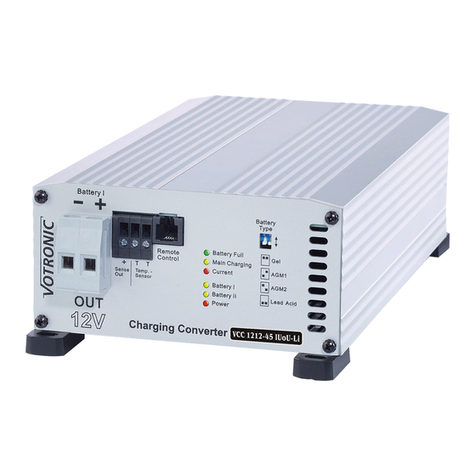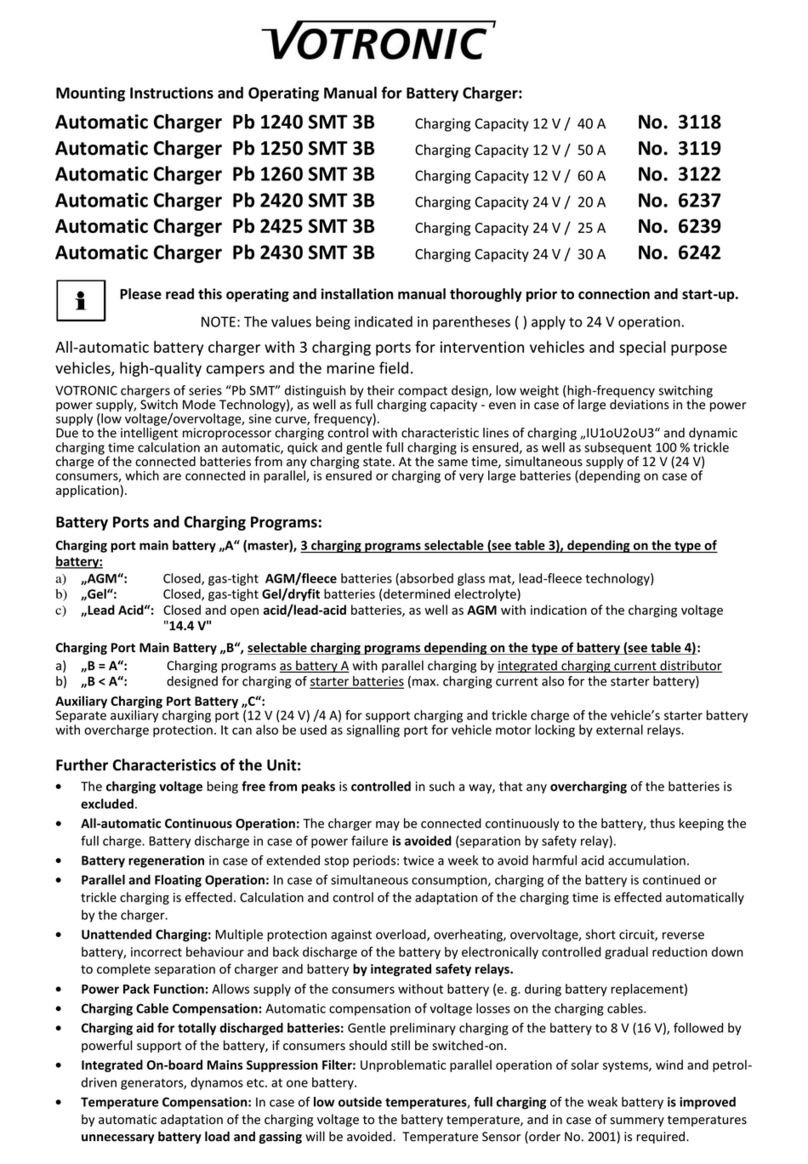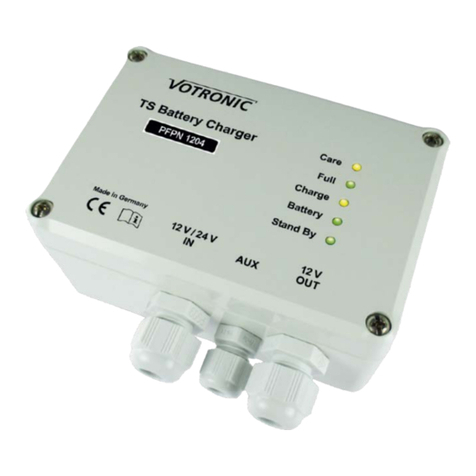--10--
Indicator Lamps:
„Battery Full“ (Battery (Batteries) fully charged, green)):
If it is lighting: Battery (batteries) has (have) been charged to 100 %, trickle charge U2, finished.
If it is flashing: Main charging process in the charging phase U1 is in progress, charging state is
increasing from approx. 75 % to 100 %.
Off: Main charging process is still being executed in the phase I.
„Main Charging“ (Main charging, yellow):
If it is lighting: Main charging process is effected in the charging phase I or U1.
Off: Trickle charge U2.
If it is flashing: 1. Disconnection of the battery protection: battery “A” temperature <-40 ° C or temperature
rise (depending on type, e.g. 57 ° C or 63 ° C), automatic reset in case of slight cooling off,
or
2. External battery overvoltage > 15.50 V (> 31.0 V) after 20 seconds
automatic reset <12.75 V (<25.5 V) after 30 seconds
„Current“ (Charging Current, red):
The lighting intensity of the LED „Current“ (Charging Current) will be reduced or increased depending on the
supplied charging current.
„Power / Attention“ (Mains, red):
If it is lighting: Mains supply is available and charger is ready for operation.
If it is flashing: Disconnection of the safety timer, duration of the charging phase I was too long,
battery defective (short-circuit of the cells), too many consumers, switch „Cap“ has been set to a
value, which is too low. Reset is only possible by switching the mains switch to OFF.
Or internal unit failure (overheating), automatic reset after cooling down.
„Battery A“ (yellow):
If it is lighting: Main battery „A“ will be charged.
„Battery Start“ (yellow):
If it is lighting: Starter battery of the vehicle is charged.
Charging Process Main Battery „A“:
A new, complete main charging cycle will be executed:
After a power failure or disconnection by means of the mains switch (position „O“) the unit plug or mains plug
must be withdrawn.
In case of a lower deviation of the battery reset voltage of 12,75 V (25,50 V) beyond the maximum charger current
for 30 seconds due to high load.
1. Charging aid for totally discharged battery: From 1.0 V, preliminary gentle charging with a small current rate up
to 8 V (16 V).
2. Maximum charging current (Phase I) in the mean voltage range from 8 V (16 V) to the beginning of the phase
U1 for short charging times. The LED „Main Charging“ is lighting, and 75 -80 % of the capacity will be
charged. The duration of the phase I depends on the battery conditions, the floating load and the charging state.
The charger records the charging process and switches automatically to the next phase U1. If the duration of the
charging phase I was too long, the charger will be switched-off (safety timer against cell defects etc., the LED
„Power/Attention“ is flashing).
3. During the Phase U1 (LED „Main Charging“ is lighting) the battery voltage will be kept constantly on a high
level. The green LED „Battery Full“ is flashing, and the additional high
battery capacity over 80 % will be charged. The battery charging current is decreased slowly while full charging
is increasing. The charger controls the charging time as well as the charging current. From these values and from
the course of charging being recorded during the phase I, the charger determines the 100 % full charge point of
the battery for automatic commutation to U2.
In contrast to conventional chargers with fixed default values for charging current commutation, an unnecessary
long phase U1 is avoided, which might be caused by floating loads being eventually also supplied, and which are
falsifying the charging current.
„Main Charging“ will stop lighting.
4. Phase U2 ( „Battery Full“ is lighting permanently, 100 %): The charger has now switched to the lower
voltage for trickle charge maintaining 100 % charge of the battery. Only the low compensating recharging
current is flowing, which is determined by the battery, and which is required for constant conservation of the full
charge.
5. Battery Regeneration: To ensure a circulation of acid accumulation in case of extended periods of trickle
charge (due to e. g. stop periods of the vehicle), the charging voltage rate will be raised automatically to U1
twice a week for one hour. After that, direct return to U2.
Note: During the phases U1, U2 (Battery Full) almost the total charger current is available
for additional supply of consumers without any discharge of the battery.



































